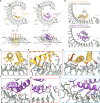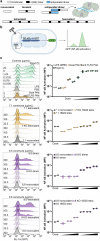De novo design of protein minibinder agonists of TLR3
- PMID: 39890776
- PMCID: PMC11785957
- DOI: 10.1038/s41467-025-56369-w
De novo design of protein minibinder agonists of TLR3
Abstract
Toll-like Receptor 3 (TLR3) is a pattern recognition receptor that initiates antiviral immune responses upon binding double-stranded RNA (dsRNA). Several nucleic acid-based TLR3 agonists have been explored clinically as vaccine adjuvants in cancer and infectious disease, but present substantial manufacturing and formulation challenges. Here, we use computational protein design to create novel miniproteins that bind to human TLR3 with nanomolar affinities. Cryo-EM structures of two minibinders in complex with TLR3 reveal that they bind the target as designed, although one partially unfolds due to steric competition with a nearby N-linked glycan. Multivalent forms of both minibinders induce NF-κB signaling in TLR3-expressing cell lines, demonstrating that they may have therapeutically relevant biological activity. Our work provides a foundation for the development of specific, stable, and easy-to-formulate protein-based agonists of TLRs and other pattern recognition receptors.
© 2025. The Author(s).
Conflict of interest statement
Competing interests: A provisional patent application has been filed by the University of Washington on the TLR3 minibinders described here, listing C.S.A., B.C., and N.P.K. as co-inventors. The King lab has received unrelated sponsored research agreements from Pfizer and GSK. The remaining authors declare no competing interests.
Figures




Update of
-
De novo design of protein minibinder agonists of TLR3.bioRxiv [Preprint]. 2024 Apr 18:2024.04.17.589973. doi: 10.1101/2024.04.17.589973. bioRxiv. 2024. Update in: Nat Commun. 2025 Jan 31;16(1):1234. doi: 10.1038/s41467-025-56369-w. PMID: 38659926 Free PMC article. Updated. Preprint.
References
-
- Taro Kawai, S. A. Pathogen recognition with Toll-like receptors. Curr. Opin. Immunol.17, 338–344 (2005). - PubMed
-
- Medzhitov, R., Preston-Hurlburt, P. & Janeway, C. A. A human homologue of the Drosophila Toll protein signals activation of adaptive immunity. Nature388, 394–397 (1997). - PubMed
-
- Akira, S., Takeda, K. & Kaisho, T. Toll-like receptors: critical proteins linking innate and acquired immunity. Nat. Immunol.2, 675–680 (2001). - PubMed
-
- Kim, H. M. et al. Crystal structure of the TLR4-MD-2 complex with bound endotoxin antagonist eritoran. Cell130, 906–917 (2007). - PubMed
MeSH terms
Substances
Grants and funding
LinkOut - more resources
Full Text Sources

